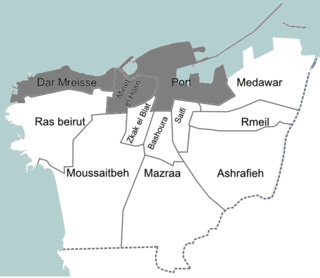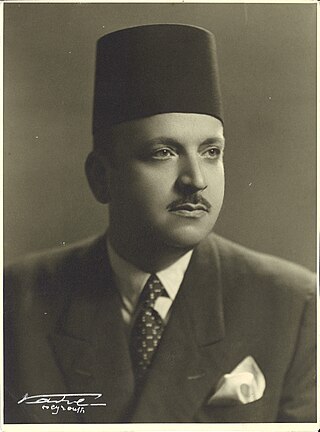
Keserwan District is a district (qadaa) in Keserwan-Jbeil Governorate, Lebanon, to the northeast of Lebanon's capital Beirut. The capital, Jounieh, is overwhelmingly Maronite Christian. The area is home to the Jabal Moussa Biosphere Reserve.

Takieddin el-Solh was a Lebanese politician who served as the Prime Minister of Lebanon from 1973 to 1974, and again briefly in 1980.
General elections were held in Lebanon between 12 July and 9 August 1953, the first under the new electoral system which allowed candidates to win with a plurality of votes, rather than requiring a second round. Independent candidates won the majority of seats. Voter turnout was 50.0%.

Beirut II was a parliamentary constituency in Lebanon. It covered three neighbourhoods (quartiers) in the north-eastern parts of the capital; Port, Medawar and Bachoura. The constituency elected four members of the National Assembly. Two of the Beirut II MPs had to be Armenian Orthodox, 1 Sunni Muslim and 1 Shia Muslim. The constituency was created with the 2008 Doha Agreement, ahead of the 2009 parliamentary election.

Beirut III was an electoral district in Lebanon. It covered six neighbourhoods (quartiers) in the western parts of the capital; Dar El Mreisse, Mazraa, Minet El Hosn, Moussaitbeh, Ras Beirut and Zuqaq al-Blat. The constituency elected ten members of the Parliament of Lebanon; five Sunni Muslim, one Shia Muslim, one Druze, one Protestant, one Greek Orthodox and one Minorities. The constituency was created with the 2008 Doha Agreement, ahead of the 2009 parliamentary election.

General elections were held in Lebanon on 6 May 2018. Although originally scheduled for 2013, the election was postponed three times in 2013, 2014 and 2017 under various pretexts, including the security situation, the failure of the Parliament to elect a new President, and the technical requirements of holding an election. A new electoral law adopted in 2017 provides a proportional representation system for the first time.
Muhammad Baydoun was a moderate Lebanese politician and served as a member of the Lebanese parliament from 1992 until 2005. He also served as minister of power and energy as recently as 2005. He participated in many rallies organized by the 14 March coalition.
Voting to elect three members of the Lebanese parliament took place in the Beirut II district on March 24, 1968, part of the national general election of that year. The constituency had 34,113 eligible voters, out of whom 17,004 voted.
Voting to elect five members of the Lebanese parliament took place in the Beirut III district on March 24, 1968, part of the national general election of that year. The constituency had 75,296 eligible voters, out of whom 30,713 voted.
Voting to elect five members of the Lebanese parliament took place in Tripoli City in 1968, part of the national general election of that year. Four of the seats of the constituency were earmarked for the Sunni Muslim community, whilst the fifth seat was allocated to the Greek Orthodox community. The Tripoli City constituency had 64,913 eligible voters, out of whom 22,813 voted.
Farid Youssef Jubran was a Lebanese Latin Catholic politician. He was born in 1911. Jubran was one of the co-founders of the Progressive Socialist Party in 1949. Outside politics Jubran owned a Beirut-based auditing firm.

In Lebanese politics Minorities is a term that includes six different Christian sects; Syriac Orthodox, Syriac Catholics, Assyrian Church of the East, Chaldean Catholics, Latin Catholics and Coptic Orthodox. 1 of the 128 seats in the national parliament is allocated to Minorities. The Minorities' seat is elected from Beirut III electoral district, an electoral district with a large Sunni Muslim majority.

Beirut V – Minet El Hosn was an electoral district in Lebanon, used in the 1953 parliamentary election. The electoral district covered three neighbourhoods of Beirut and elected a Minorities parliamentarian. Joseph Chader of the Kataeb Party was elected from the district in 1953.
Joseph Chader was a Lebanese Armenian Catholic politician. He was a Member of Parliament between 1951 and 1977, and served as deputy speaker at times. In 1958 he became the first Armenian government minister in Lebanon. He served as vice chairman of the Kataeb Party.

Bint Jbeil electoral district was an electoral district in Lebanon. It covered all areas of the Bint Jbeil District. The constituency elected three Shia Muslim members of the Parliament of Lebanon.

Beirut I is an electoral district in Lebanon. The district elects eight members of the Lebanese National Assembly – three Armenian Orthodox, one Armenian Catholic, one Greek Catholic, one Greek Orthodox, one Maronite and one Minorities.

Beirut II is an electoral district in Beirut, Lebanon, as per the 2017 vote law. The district elects 11 members of the Lebanese National Assembly - 6 Sunnis, 2 Shias, 1 Druze, 1 Greek Orthodox, 1 Evangelical.

Kazem El-Solh was a Lebanese politician, a diplomat and the founder of a political party and a newspaper. He was a member of parliament in Lebanon and served as the country's ambassador to Iraq.

General elections were held in Lebanon on 15 May 2022. The country has for several years been the subject of chronic political instability as well as a serious economic crisis aggravated by the 2020 explosions that hit the Port of Beirut and faced large-scale demonstrations against the political class.

Voting to elect eleven members of the Lebanese parliament took place in the Beirut II district on 6 May 2018, part of the general election of that year. The constituency had 353,164, out of whom 143,829 voted. Residents elect 6 Sunnis, 2 Shias, 1 Druze, 1 Greek Orthodox and 1 Evangelical.













